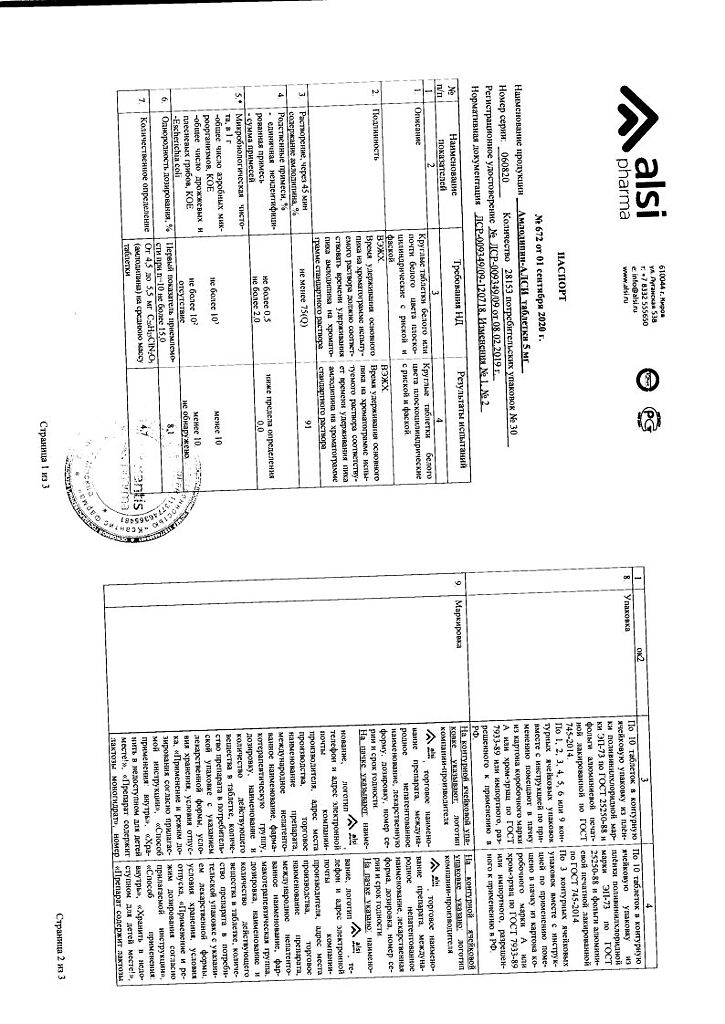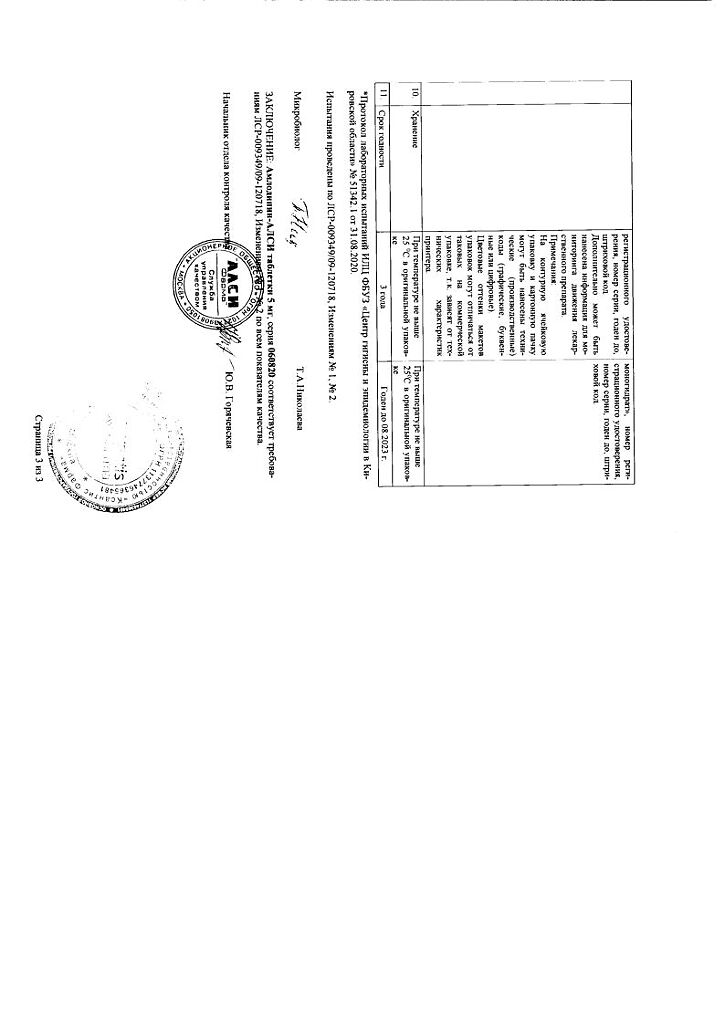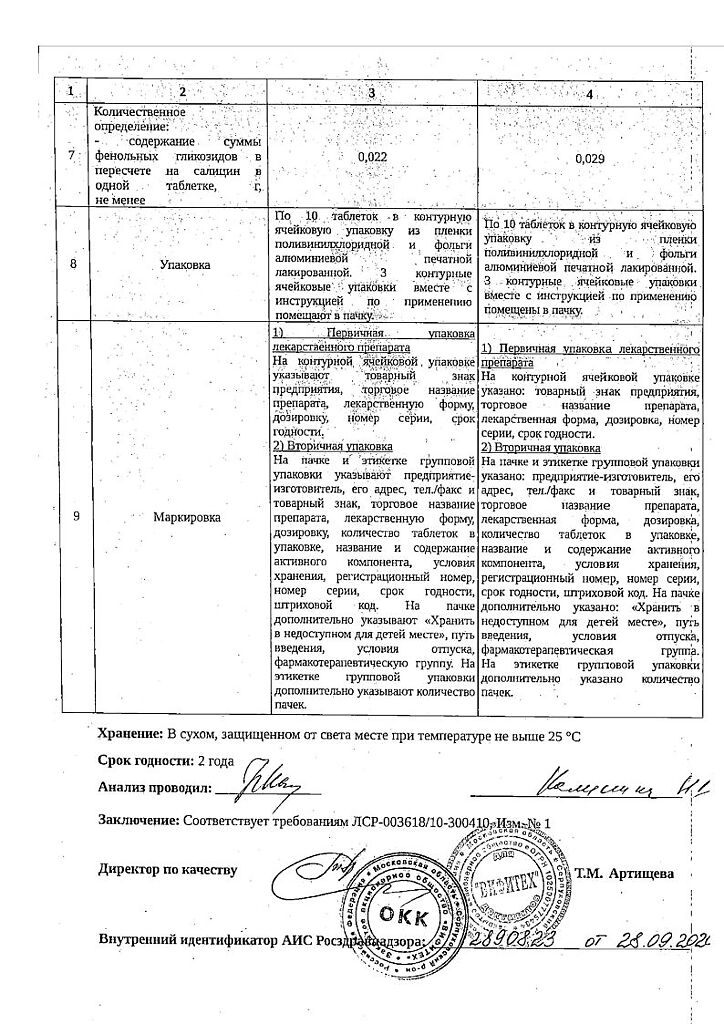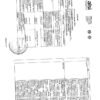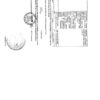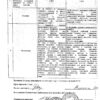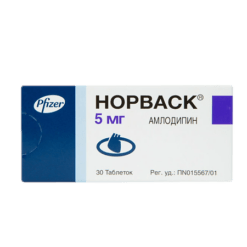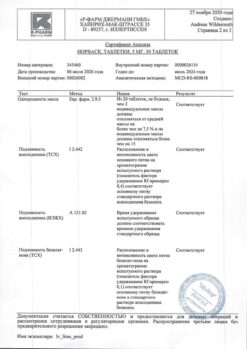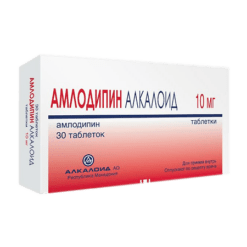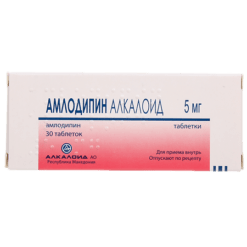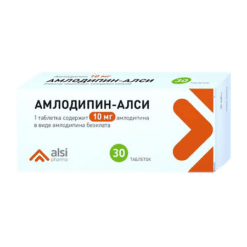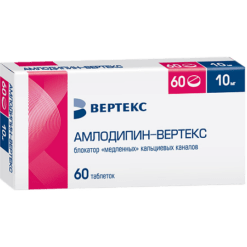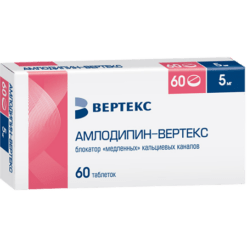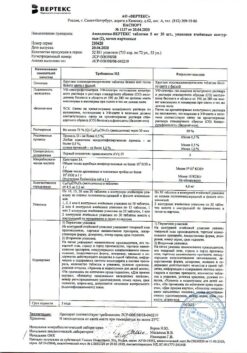No products in the cart.
Amlodipine-ALSI, tablets 5 mg 30 pcs
€1.36 €1.13
Description
Dihydropyridine derivative is a “slow” calcium channels blocker (BMCC) of II generation, has antianginal and hypotensive effects. By binding to dihydropyridine receptors, it blocks calcium channels, reduces transmembrane transfer of calcium ions into cell (more in vascular smooth muscle cells than in cardiomyocytes).
The antianginal action is caused by the dilation of coronary and peripheral arteries and arterioles: in angina pectoris it reduces myocardial ischemia; dilation of peripheral arterioles reduces total peripheral vascular resistance (TPR), decreases cardiac preload, reduces myocardial oxygen demand.
Dilates main coronary arteries and arterioles in unchanged and ischemic areas of the myocardium, increases oxygen supply to the myocardium (especially in vasospastic angina); prevents development of coronary artery spasm (including that caused by smoking). In patients with stable angina a single daily dose increases exercise tolerance, slows down the development of angina and “coronary” ST-segment depression, reduces the frequency of angina attacks and the use of nitroglycerin and other nitrates.
It has a long-term dose-dependent hypotensive effect. The hypotensive effect is due to a direct vasodilating effect on the vascular smooth muscles. In arterial hypertension, a single dose provides clinically significant reduction of blood pressure (BP) for 24 hours (in the position of the patient “lying” and “standing”). Orthostatic hypotension when prescribing amlodipine is quite rare. It does not cause reduction of exercise tolerance and left ventricular ejection fraction.
Limits the degree of myocardial hypertrophy of the left ventricle, has anti-atherosclerotic and cardioprotective effect in coronary heart disease (CHD). It does not affect myocardial contractility and conduction, does not cause reflex increase in heart rate (HR), inhibits platelet aggregation, increases glomerular filtration rate, has a weak natriuretic effect. In diabetic nephropathy it does not increase the severity of microalbuminuria. It has no adverse effect on metabolism and concentration of plasma lipids and can be used for treatment of patients with bronchial asthma, diabetes mellitus and gout.
The significant decrease in BP is observed after 6-10 hours, the duration of the effect is 24 hours. With prolonged therapy, the maximum BP decrease occurs 6-12 hours after oral amlodipine administration. If after prolonged treatment amlodipine is stopped, effective BP reduction is maintained for 48 hours after the last dose. Then BP values gradually return to baseline within 5-6 days.
Indications
Indications
Arterial hypertension (monotherapy or in combination with other antihypertensive drugs).
Stable angina pectoris and vasospastic angina (Prinzmetal angina) (monotherapy or in combination with other antihypertensive drugs).
Pharmacological effect
Pharmacological effect
The dihydropyridine derivative is a second generation blocker of “slow” calcium channels (SCCC), has an antianginal and hypotensive effect. By binding to dihydropyridine receptors, it blocks calcium channels, reduces the transmembrane transition of calcium ions into the cell (more into vascular smooth muscle cells than into cardiomyocytes).
The antianginal effect is due to the expansion of the coronary and peripheral arteries and arterioles: in case of angina pectoris, it reduces the severity of myocardial ischemia; by expanding peripheral arterioles, it reduces total peripheral vascular resistance (TPVR), reduces preload on the heart, and reduces myocardial oxygen demand.
Expands the main coronary arteries and arterioles in unchanged and ischemic areas of the myocardium, increases the supply of oxygen to the myocardium (especially with vasospastic angina); prevents the development of spasm of the coronary arteries (including those caused by smoking). In patients with stable angina, a single daily dose increases exercise tolerance, slows down the development of angina and “ischemic” depression of the ST segment, reduces the frequency of angina attacks and the consumption of nitroglycerin and other nitrates.
It has a long-term dose-dependent hypotensive effect. The hypotensive effect is due to a direct vasodilating effect on vascular smooth muscle. For arterial hypertension, a single dose provides a clinically significant reduction in blood pressure (BP) over 24 hours (in the patient’s “lying” and “standing” position). Orthostatic hypotension when prescribing amlodipine is quite rare. Does not cause a decrease in exercise tolerance or left ventricular ejection fraction.
Reduces the degree of left ventricular myocardial hypertrophy, has an antiatherosclerotic and cardioprotective effect in coronary heart disease (CHD). It has no effect on myocardial contractility and conductivity, does not cause a reflex increase in heart rate (HR), inhibits platelet aggregation, increases the glomerular filtration rate, and has a weak natriuretic effect. In diabetic nephropathy, it does not increase the severity of microalbuminuria. It does not have any adverse effect on metabolism and plasma lipid concentrations and can be used in the treatment of patients with bronchial asthma, diabetes mellitus and gout.
A significant decrease in blood pressure is observed after 6-10 hours, the duration of the effect is 24 hours. With long-term therapy, the maximum reduction in blood pressure occurs 6-12 hours after taking amlodipine orally. If amlodipine is discontinued after long-term treatment, the effective reduction in blood pressure persists for 48 hours after the last dose. Then blood pressure levels gradually return to the original level over 5-6 days.
Special instructions
Special instructions
During treatment with Amlodipine, it is necessary to monitor body weight and sodium intake, and prescribe an appropriate diet. It is necessary to maintain dental hygiene and follow-up with a dentist (to prevent pain, bleeding and gum hyperplasia).
Patients with low body weight, patients of short stature and patients with severe liver dysfunction may require a lower dose.
In elderly patients, T1/2 and drug clearance may be prolonged. No dose changes are required for elderly patients; When increasing the dose, more careful monitoring of patients is necessary.
If liver function is impaired, T1/2 of the drug may also be prolonged. Therefore, Amlodipine should be prescribed to such patients with caution.
Despite the fact that discontinuation of Amlodipine is not accompanied by the development of withdrawal syndrome, it is advisable to discontinue treatment by gradually reducing the dose of the drug.
The effectiveness and safety of the drug in hypertensive crisis have not been established.
Effect on the ability to drive a car and other complex mechanisms: there have been no reports of the effect of Amlodipine on driving a car or working with machinery. However, some patients, mainly at the beginning of treatment, may experience drowsiness and dizziness. If they occur, the patient must take special precautions when driving a car and working with complex mechanisms.
Active ingredient
Active ingredient
Amlodipine
Composition
Composition
One tablet contains:
as an active ingredient:
amlodipine besilate – 6.9 mg, which corresponds to 5 mg of amlodipine;
excipients:
lactose monohydrate – 85.7 mg,
povidone – 3.2 mg,
crospovidone – 3.2 mg,
calcium stearate – 1.0 mg.
Contraindications
Contraindications
Hypersensitivity to amlodipine, dihydropyridine derivatives and other components of the drug;
severe arterial hypotension (systolic blood pressure less than 90 mm Hg);
collapse, cardiogenic shock;
unstable angina (with the exception of Prinzmetal’s angina);
clinically significant aortic stenosis;
pregnancy and lactation;
age under 18 years (efficacy and safety have not been studied);
lactase deficiency, lactose intolerance, glucose-galactose malabsorption.
Use with caution in: liver dysfunction, sick sinus syndrome (SSNS) (severe bradycardia, tachycardia), chronic heart failure of non-ischemic etiology of functional class III-IV according to the NYHA classification, arterial hypotension, aortic stenosis, mitral stenosis, hypertrophic obstructive cardiomyopathy (HOCM), acute myocardial infarction (and within 1 month after myocardial infarction), in old age.
Side Effects
Side Effects
World Health Organization (WHO) side effect frequency classification:
very often >1/10
often >1/100 to <1/10
sometimes from > 1/1000 to < 1/100
rarely >1/10000 to <1/1000
very rare from <1/10000, including isolated reports.
From the cardiovascular system: often – palpitations, peripheral edema (swelling of the ankles and feet), “flushes” of blood to the skin of the face; sometimes – an excessive decrease in blood pressure; very rarely – syncope, shortness of breath, vasculitis, orthostatic hypotension, development or worsening of heart failure, cardiac arrhythmias (including bradycardia, ventricular tachycardia and atrial fibrillation), myocardial infarction, chest pain.
From the central and peripheral nervous system: often – headache, dizziness, increased fatigue, drowsiness; sometimes – asthenia, general malaise, hypoesthesia, paresthesia, peripheral neuropathy, tremor, insomnia, mood lability, unusual dreams, nervousness, depression, anxiety, very rarely – migraine, increased sweating, apathy.
From the digestive system: often – nausea, abdominal pain; sometimes – vomiting, constipation or diarrhea, flatulence, dyspepsia, anorexia, dry mouth, thirst;
rarely – gum hyperplasia, increased appetite; very rarely – pancreatitis, gastritis, jaundice (due to cholestasis), hyperbilirubinemia, increased activity of liver transaminases, hepatitis.
From the hematopoietic organs: very rarely – thrombocytopenic purpura, leukopenia, thrombocytopenia.
From the genitourinary system: sometimes – frequent urination, painful urination, nocturia, impotence, very rarely – dysuria, polyuria, gynecomastia.
From the respiratory system: sometimes – shortness of breath, rhinitis, very rarely – cough.
From the skin: rarely – dermatitis, very rarely – alopecia, xeroderma, “cold” sweat, skin pigmentation disorder.
Allergic reactions: skin itching, rash (including erythematous, maculopapular rash, urticaria), angioedema, erythema multiforme.
From the musculoskeletal system: sometimes – muscle cramps, myalgia, arthralgia, back pain, arthrosis, rarely – myasthenia gravis.
Other: sometimes – ringing in the ears, diplopia, disturbance of accommodation, xerophthalmia, conjunctivitis, eye pain, chills, nosebleeds, very rarely – parosmia, hyperglycemia.
Interaction
Interaction
Amlodipine can be safely used for the treatment of hypertension together with thiazide diuretics, alpha-blockers, beta-blockers or ACE inhibitors. In patients with stable angina, the drug can be combined with other antianginal agents, for example, long-acting nitrates, beta-blockers or short-acting nitrates.
Amlodipine can be used concomitantly with non-steroidal anti-inflammatory drugs (NSAIDs) (especially indomethacin), antibacterial agents and oral hypoglycemic agents.
It is possible to enhance the antianginal and hypotensive effect of BMCC when used together with thiazide and loop diuretics, verapamil, ACE inhibitors, beta-blockers and nitrates, as well as enhance their hypotensive effect when used together with alpha1-blockers, antipsychotics.
Although negative inotropic effects have not generally been observed in amlodipine studies, some CBMCs may enhance the negative inotropic effects of antiarrhythmic drugs that cause QT prolongation (eg, amiodarone and quinidine).
A single dose of 100 mg of sildenafil in patients with essential hypertension does not affect the pharmacokinetic parameters of amlodipine.
Repeated use of amlodipine at a dose of 10 mg and atorvastatin at a dose of 80 mg is not accompanied by significant changes in the pharmacokinetics of atorvastatin.
Ethanol (drinks containing alcohol): amlodipine with single and repeated use in a dose of 10 mg does not affect the pharmacokinetics of ethanol.
Antiviral agents (ritonavir) increase plasma concentrations of BMCC, incl. amlodipine.
Neuroleptics and isoflurane – enhance the hypotensive effect of dihydropyridine derivatives.
Calcium supplements may reduce the effect of BMCC.
When amlodipine is used together with lithium preparations, it is possible to increase the manifestation of neurotoxicity (nausea, vomiting, diarrhea, ataxia, tremor, tinnitus).
Amlodipine does not change the pharmacokinetics of cyclosporine.
Does not affect the serum concentration of digoxin and its renal clearance.
Does not have a significant effect on the effect of warfarin (prothrombin time).
Cimetidine does not affect the pharmacokinetics of amlodipine.
In in vitro studies, amlodipine does not affect the binding of digoxin, phenytoin, warfarin and indomethacin to blood proteins.
Grapefruit juice: simultaneous single administration of 240 mg of grapefruit juice and 10 mg of amlodipine orally is not accompanied by a significant change in the pharmacokinetics of amlodipine.
Overdose
Overdose
Symptoms: excessive peripheral vasodilation with a pronounced and possibly prolonged decrease in blood pressure, collapse, shock.
Treatment: gastric lavage, administration of activated charcoal, maintaining the function of the cardiovascular system, monitoring indicators of heart and lung function, elevated, above head level, position of the lower extremities, monitoring circulating blood volume and diuresis. To restore vascular tone – use vasoconstrictors (in the absence of contraindications to their use); in order to eliminate the consequences of blockade of calcium channels – intravenous administration of calcium gluconate. Hemodialysis is ineffective.
Recommendations for use
Recommendations for use
Orally, the initial dose for the treatment of arterial hypertension and angina pectoris is 5 mg of the drug once a day. The maximum daily dose is 10 mg once.
For arterial hypertension, the maintenance dose can be 2.5 – 5 mg (1/2 tablet of 5 mg – 1 tablet of 5 mg) per day.
For exertional angina and vasospastic angina – 5-10 mg per day, once. To prevent angina attacks – 10 mg/day.
In patients with impaired liver function, Amlodipine is prescribed with caution as an antihypertensive agent, at an initial dose of 2.5 mg (1/2 tablet of 5 mg), and as an antianginal agent – 5 mg.
In elderly patients, T1/2 of Amlodipine may increase and creatinine clearance (CC) may decrease. No dose changes are required, but patients should be monitored more closely.
No dose change is required when administered concomitantly with thiazide diuretics, beta-blockers and angiotensin-converting enzyme (ACE) inhibitors.
No dose changes are required in patients with renal failure.
Functional features
Functional features
After oral administration, amlodipine is slowly absorbed from the gastrointestinal tract (GIT). The average absolute bioavailability is 64%, the maximum concentration (Cmax) in the blood serum is observed after 6-9 hours. Steady-state serum concentrations (Css) are achieved after 7-8 days of therapy. Food intake does not affect the absorption of amlodipine.
The mean volume of distribution is 21 L/kg body weight, indicating that most of the drug is in the tissues and a relatively smaller portion is in the blood. Most of the drug in the blood (95%) binds to blood plasma proteins.
Amlodipine undergoes slow but active metabolism in the liver with no significant first-pass effect. Metabolites do not have significant pharmacological activity.
After a single oral dose, the half-life (T1/2) varies from 31 to 48 hours; with repeated administration, T1/2 is approximately 45 hours. About 60% of the dose taken orally is excreted by the kidneys mainly in the form of metabolites, 10% unchanged, and 20-25% through the intestines, as well as with breast milk. The total clearance of amlodipine is 0.116 ml/s/kg (7 ml/min/kg, 0.42 l/h/kg).
In elderly patients (over 65 years of age), the elimination of amlodipine is slower (T1/2 – 65 hours) compared to young patients, but this difference is not clinically significant. Prolongation of T1/2 in patients with liver failure suggests that with long-term administration, the accumulation of the drug in the body will be higher (T1/2 – up to 60 hours). Renal failure does not significantly affect the kinetics of amlodipine. The drug penetrates the blood-brain barrier. It is not removed by hemodialysis.
Storage conditions
Storage conditions
In a dry place, protected from light, at a temperature not exceeding 25°C.
Keep out of the reach of children.
Shelf life
Shelf life
3 years.
Do not use after expiration date.
Manufacturer
Manufacturer
ALSI Pharma, Russia
Additional information
| Shelf life | 3 years. Do not use after the expiration date. |
|---|---|
| Conditions of storage | In a dry, light-protected place at a temperature not exceeding 25°C. Store out of the reach of children. |
| Manufacturer | ALSI Pharma, Russia |
| Medication form | pills |
| Brand | ALSI Pharma |
Other forms…
Related products
Buy Amlodipine-ALSI, tablets 5 mg 30 pcs with delivery to USA, UK, Europe and over 120 other countries.


